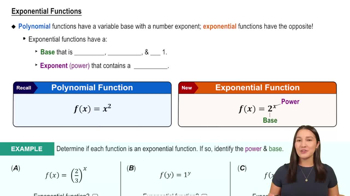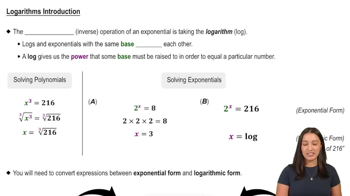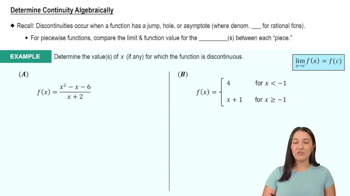Graph the given function.
Table of contents
- 0. Functions7h 54m
- Introduction to Functions16m
- Piecewise Functions10m
- Properties of Functions9m
- Common Functions1h 8m
- Transformations5m
- Combining Functions27m
- Exponent rules32m
- Exponential Functions28m
- Logarithmic Functions24m
- Properties of Logarithms36m
- Exponential & Logarithmic Equations35m
- Introduction to Trigonometric Functions38m
- Graphs of Trigonometric Functions44m
- Trigonometric Identities47m
- Inverse Trigonometric Functions48m
- 1. Limits and Continuity2h 2m
- 2. Intro to Derivatives1h 33m
- 3. Techniques of Differentiation3h 18m
- 4. Applications of Derivatives2h 38m
- 5. Graphical Applications of Derivatives6h 2m
- 6. Derivatives of Inverse, Exponential, & Logarithmic Functions2h 37m
- 7. Antiderivatives & Indefinite Integrals1h 26m
- 8. Definite Integrals4h 44m
- 9. Graphical Applications of Integrals2h 27m
- 10. Physics Applications of Integrals 3h 16m
- 11. Integrals of Inverse, Exponential, & Logarithmic Functions2h 31m
- 12. Techniques of Integration7h 41m
- 13. Intro to Differential Equations2h 55m
- 14. Sequences & Series5h 36m
- 15. Power Series2h 19m
- 16. Parametric Equations & Polar Coordinates7h 58m
0. Functions
Exponential Functions
Problem 1.42
Textbook Question
Solve each equation.
48=6e4k
 Verified step by step guidance
Verified step by step guidance1
Start by isolating the exponential term. Divide both sides of the equation by 6 to get: \( e^{4k} = \frac{48}{6} \).
Simplify the right side of the equation: \( e^{4k} = 8 \).
To solve for \( k \), take the natural logarithm of both sides: \( \ln(e^{4k}) = \ln(8) \).
Use the property of logarithms that \( \ln(e^x) = x \) to simplify the left side: \( 4k = \ln(8) \).
Finally, solve for \( k \) by dividing both sides by 4: \( k = \frac{\ln(8)}{4} \).
 Verified video answer for a similar problem:
Verified video answer for a similar problem:This video solution was recommended by our tutors as helpful for the problem above
Video duration:
2mPlay a video:
Was this helpful?
Key Concepts
Here are the essential concepts you must grasp in order to answer the question correctly.
Exponential Functions
Exponential functions are mathematical expressions in the form of f(x) = a * e^(bx), where 'e' is the base of natural logarithms, approximately equal to 2.71828. These functions model growth or decay processes and are characterized by their rapid increase or decrease. Understanding how to manipulate and solve equations involving exponential functions is crucial for solving problems like the one presented.
Recommended video:

Exponential Functions
Logarithms
Logarithms are the inverse operations of exponentiation, allowing us to solve for the exponent in equations of the form a^x = b. The natural logarithm, denoted as ln, specifically deals with the base 'e'. In the context of the given equation, applying logarithms helps isolate the variable 'k' by transforming the exponential equation into a linear form, making it easier to solve.
Recommended video:

Logarithms Introduction
Algebraic Manipulation
Algebraic manipulation involves rearranging and simplifying equations to isolate variables or solve for unknowns. This includes operations such as addition, subtraction, multiplication, division, and applying properties of equality. In the context of the given equation, effective algebraic manipulation is necessary to isolate 'e^(4k)' and subsequently apply logarithmic properties to find the value of 'k'.
Recommended video:

Determine Continuity Algebraically

 6:13m
6:13mWatch next
Master Exponential Functions with a bite sized video explanation from Patrick
Start learningRelated Videos
Related Practice
Multiple Choice
